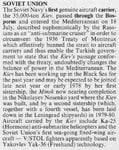I'm not really sure where to post this, it has aircraft, but its main theme is the titular 'aircraft carrier'; the rather impressive Soviet Navy aircraft carrying heavy cruiser Kiev. Bought by a Chinese entertainment consortium in 1996, the Kiev was intended on being converted into a floating hotel, but despite rooms having been built, the 'hotel' has yet to be opened. Instead, the carrier forms the centrepiece of the oddest theme park, celebrating, or commiserating Russian culture in a very kitschy fashion. Naturally there is Chinese military hardware on site, including armoured vehicles and a smattering of Shenyang J-6 fighters painted to resemble 'MiGs', but the whole thing is very contrived. There's also a water show with pyrotechnics and bad guys on jetskis riding around the bow of the ship. I decided to avoid watching this for going aboard the carrier. Despite all this, walking on the deck of a former Soviet aircraft carrier is worth the lengthy journey time and so it should definitely be on your list of things to do if you find yourself in Beijing.
The park is located in the TEDA (Tianjin Economic Development Area), Binhai New Area on the coast of the Bohai Sea, near the city of Tianjin, but it is closer to Tanngu. Catch a bullet train to Tanngu from Beijing South Station; it takes 45 - 50 minutes (at 300 kph) and gets you closer to the park than going to Tianjin itself. You'll need to get a taxi from Tanngu, as I don't think there's public transport. Anyway, photos and a link below.
 Binhai 12
Binhai 12
Shenyang J-6 (MiG-19) garden ornaments. Lots of these dotted about the park.
 Kiev 2
Kiev 2
What most people go to see, the Kiev. Entrance to the aircraft carrier is through the stairs entering into the torpedo tube hatch.
 Kiev 16
Kiev 16
The magazine for the enormous P-500 anti-ship cruise missiles, of which a number of full scale reproductions fill in for the real weapons. The lift to deck level is a vast rectangular chasm through the centre of the ship.
 Kiev 17
Kiev 17
The hangar deck has an odd mix of model aircraft, including this full scale Shenyang J-10 fighter located on the flight deck lift, which is not carrier capable and would struggle to reach take off speed flying from Kiev's short deck!
 Kiev 37
Kiev 37
I'm sure the Coca Cola emblazoned tables welded to the flight deck weren't there in Soviet service! Neither were the Nanchang Q-5s!
 Kiev 80
Kiev 80
For such a large and impressive vessel, Kiev's bridge appears sparsely equipped.
 Kiev 87
Kiev 87
Kiev and her three sisters were formidably armed, with their main armament located on the deck forward of the conning tower.
 Kiev 100
Kiev 100
Externally, the Kiev is an impressive vessel, despite the fact that much of her innards have been ripped out to convert it into a hotel.
 Type 035 1
Type 035 1
There's also a submarine, Type 035 Ming Class...
 Type 051 1
Type 051 1
And a destroyer, Type 051, Chongqing, but non-Chinese are not allowed on board either vessel!
If this place doesn't arouse your curiosity, I don't know what will. Link to more images here:
Binhai Aircraft Carrier Theme Park
The park is located in the TEDA (Tianjin Economic Development Area), Binhai New Area on the coast of the Bohai Sea, near the city of Tianjin, but it is closer to Tanngu. Catch a bullet train to Tanngu from Beijing South Station; it takes 45 - 50 minutes (at 300 kph) and gets you closer to the park than going to Tianjin itself. You'll need to get a taxi from Tanngu, as I don't think there's public transport. Anyway, photos and a link below.
Shenyang J-6 (MiG-19) garden ornaments. Lots of these dotted about the park.
What most people go to see, the Kiev. Entrance to the aircraft carrier is through the stairs entering into the torpedo tube hatch.
The magazine for the enormous P-500 anti-ship cruise missiles, of which a number of full scale reproductions fill in for the real weapons. The lift to deck level is a vast rectangular chasm through the centre of the ship.
The hangar deck has an odd mix of model aircraft, including this full scale Shenyang J-10 fighter located on the flight deck lift, which is not carrier capable and would struggle to reach take off speed flying from Kiev's short deck!
I'm sure the Coca Cola emblazoned tables welded to the flight deck weren't there in Soviet service! Neither were the Nanchang Q-5s!
For such a large and impressive vessel, Kiev's bridge appears sparsely equipped.
Kiev and her three sisters were formidably armed, with their main armament located on the deck forward of the conning tower.
Externally, the Kiev is an impressive vessel, despite the fact that much of her innards have been ripped out to convert it into a hotel.
There's also a submarine, Type 035 Ming Class...
And a destroyer, Type 051, Chongqing, but non-Chinese are not allowed on board either vessel!
If this place doesn't arouse your curiosity, I don't know what will. Link to more images here:
Binhai Aircraft Carrier Theme Park
Last edited:

